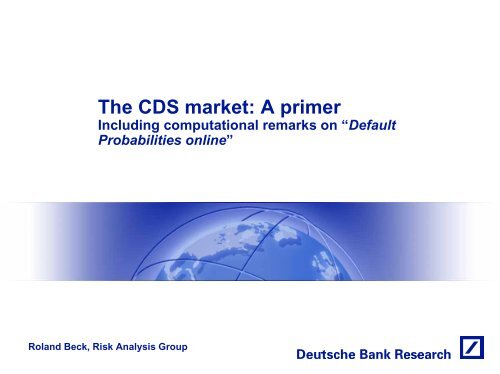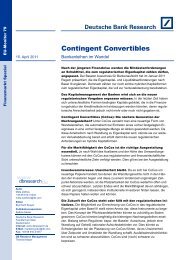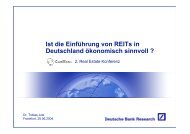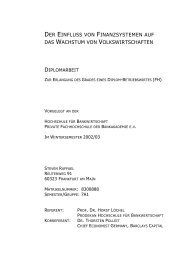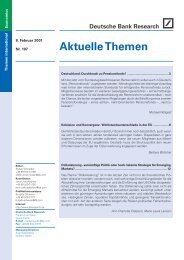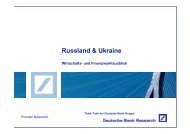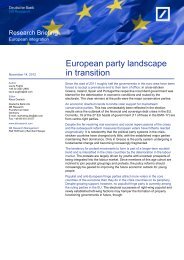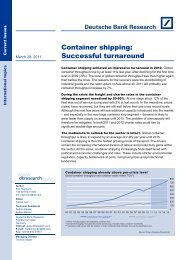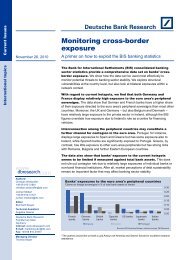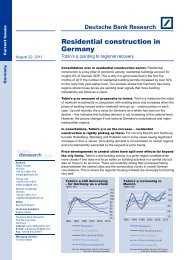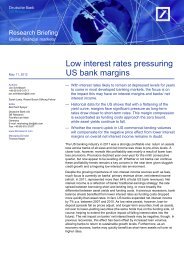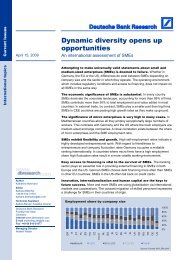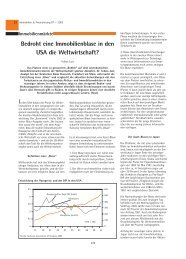The CDS market: A primer
The CDS market: A primer
The CDS market: A primer
Create successful ePaper yourself
Turn your PDF publications into a flip-book with our unique Google optimized e-Paper software.
<strong>The</strong> <strong>CDS</strong> <strong>market</strong>: A <strong>primer</strong><br />
Including computational remarks on “Default<br />
Probabilities online”<br />
Roland Beck, Risk Analysis Group
Folie 2<br />
<strong>The</strong> <strong>CDS</strong> <strong>market</strong>: A <strong>primer</strong>
Credit Default Swaps<br />
Short Introduction<br />
– <strong>CDS</strong> are similar to buying insurance against default or covered credit<br />
events<br />
– Protection buyer pays so called default swap premium, usually<br />
expressed in basis points<br />
– If specified event (mostly default) is triggered, protection seller covers<br />
occurred losses<br />
– In practice, buyer delivers specific predefined asset (bonds, loans) to<br />
seller and receives 100% of the notional specified in the <strong>CDS</strong> contract<br />
Folie 3
<strong>CDS</strong>: Methods of Settlement<br />
– Physical delivery of the reference security<br />
– Physical delivery of equivalent asset<br />
– Cash Settlement<br />
Example, Argentine plain vanilla bond, actual price = 20<br />
� Physical settlement: Protection buyer delivers reference security,<br />
protection seller has to pay 100<br />
� Cash settlement: Protection buyer receives 100-20 = 80 from<br />
protection seller and keeps security<br />
Folie 4
Credit Default Swaps<br />
Historic Market Development<br />
– Since early 1990’s <strong>CDS</strong><br />
<strong>market</strong> evolved into a major<br />
component of capital <strong>market</strong>s<br />
– Removal of current regulatory<br />
uncertainty (Basle II) is<br />
expected to lead to further<br />
rapid <strong>market</strong> growth<br />
– Sovereign <strong>CDS</strong> benefited<br />
from standardisation in<br />
’98/’99 as well as successful<br />
execution in recent defaults<br />
Folie 5<br />
-40%<br />
Elimination of Argentine reference<br />
assets after default in 2001
Credit Default Swaps<br />
Emerging Markets Focus<br />
– Emerging Markets are relatively<br />
small in absolute size<br />
– Strong focus on Sovereign<br />
<strong>CDS</strong> as they are considered<br />
the most liquid derivatives in<br />
Emerging Markets<br />
– Market liquidity generally shows<br />
strong dependency on liquidity<br />
of respective bond <strong>market</strong>s<br />
– Emerging Markets Sovereign<br />
<strong>CDS</strong> are highly concentrated in<br />
relatively few names (Top 7<br />
account for 50% of total <strong>market</strong>)<br />
Folie 6
Credit Default Swaps<br />
Latin America – Brazil bond spreads and external factors<br />
Mid ’98 – Russian crisis<br />
emerges<br />
Oct ’97 – Asian crisis<br />
hits Indonesia, Japan<br />
and Korea<br />
Folie 7<br />
Jan ’99 – BRL allowed to<br />
move freely, <strong>market</strong>s rally<br />
Jul ’02 – BRL at all-time low,<br />
financial <strong>market</strong>s panic<br />
Oct ’02 – Lula da Silva<br />
wins presidential elections<br />
Apr ’04 – Greenspan<br />
announces possibility of<br />
Fed rate increase
Credit Default Swaps<br />
Brazil – <strong>CDS</strong> as Early Warning Indicator<br />
– <strong>CDS</strong> movements generally<br />
leading bond spread<br />
movements<br />
– Applies especially for<br />
longer term changes in<br />
Sovereign risk<br />
– <strong>CDS</strong> liquidity and volumes<br />
tend to increase in view of<br />
looming crisis while bond<br />
<strong>market</strong> activity tends to<br />
shrink/dry up<br />
Folie 8<br />
4500<br />
4000<br />
3500<br />
3000<br />
2500<br />
2000<br />
1500<br />
1000<br />
500<br />
0<br />
Spread Comparison Brazil ’09 vs. 5y <strong>CDS</strong><br />
Mid ’02 – Pre-election crisis<br />
Mar-01<br />
May-01<br />
Jul-01<br />
Sep-01<br />
Nov-01<br />
Jan-02<br />
Mar-02<br />
May-02<br />
Jul-02<br />
Sep-02<br />
Nov-02<br />
Jan-03<br />
Mar-03<br />
May-03<br />
Brazil 09 <strong>CDS</strong> Brazil<br />
Jul-03<br />
Apr ’04 – Greenspan<br />
announces possibility of<br />
Fed rate increase<br />
Sep-03<br />
Nov-03<br />
Jan-04<br />
Mar-04<br />
May-04
<strong>CDS</strong> spreads versus bond spreads<br />
Shortcomings in imperfect <strong>market</strong>s<br />
– No arbitrage conditions should exist<br />
– Credit risk prices for bonds and <strong>CDS</strong> are equal over the long term<br />
– Price differentials can appear due to:<br />
Folie 9<br />
�Information unrelated to the credit risk is priced in, especially<br />
liquidity<br />
�Contractual arrangements, i.e. Sovereign <strong>CDS</strong> mostly use old<br />
ISDA ’99 restructuring clauses<br />
�Accrued interest premium for <strong>CDS</strong><br />
�Cheapest to deliver option for protection buyer<br />
�<strong>CDS</strong> spreads are quoted on Act/360 basis while bond spreads<br />
are quoted o 30/360 basis
Folie 10<br />
Computational remarks on “Default<br />
Probabilities online”
What are <strong>CDS</strong> spreads?<br />
Definition: <strong>CDS</strong> spread = Premium paid by protection buyer to the seller<br />
Quotation: In basis points per annum of the contract’s notional amount<br />
Payment: Quarterly<br />
Example: A <strong>CDS</strong> spread of 593 bp for five-year Brazilian debt means<br />
that default insurance for a notional amount of USD 1 m costs USD<br />
59,300 p.a. This premium is paid quarterly (i.e. 14,825 per quarter).<br />
Note: Concept of <strong>CDS</strong> spread (insurance premium in % of notional)<br />
Folie 11<br />
≠ Concept of yield spread (yield differential of a bond over US<br />
Treasury yield)<br />
However: Arbitrage ensures that <strong>CDS</strong> spread ≈ bond yield spread
How do <strong>CDS</strong> spreads relate to the probability of default?<br />
<strong>The</strong> simple case<br />
Consider a 1-year <strong>CDS</strong> contract and assume that the total premium is<br />
paid up front<br />
Let S: <strong>CDS</strong> spread (premium), p: default probability, R: recovery rate<br />
<strong>The</strong> protection buyer expects to pay: S<br />
His expected pay-off is (1-R)p<br />
When two parties enter a <strong>CDS</strong> trade, S is set so that the value of the<br />
swap transaction is zero, i.e.<br />
Folie 12<br />
S=(1-R)p ↔ S/(1-R)=p<br />
If R=25%, a spread of 500 bp translates into p =6.6%.<br />
If R=0, we have S=p=5%.
How do <strong>CDS</strong> spreads relate to the probability of default?<br />
<strong>The</strong> real world case<br />
Consider now the case where<br />
Maturity = N years<br />
Premium is paid in fractions d i (for quarterly payments d i =0.25)<br />
Cash flows are discounted with a discount factor from the U.S. zero<br />
curve D(t i)<br />
For convenience, let<br />
Folie 13<br />
q=1-p<br />
denote the survival probability of the reference credit with a time profile<br />
q(t i), i=1…N<br />
Assume that there is no counterparty risk.
Valuation of a <strong>CDS</strong> contract in the real world case<br />
Folie 14<br />
With proper discounting and some basic probability math, you get<br />
PV[<br />
fixed payments]<br />
PV[<br />
contingent payments] =<br />
N<br />
di<br />
∑ D(ti){q(ti<br />
1 ) − q(ti)}S<br />
2<br />
i1=<br />
4144424443 N<br />
= D(ti)q(ti)Sdi<br />
+<br />
−<br />
∑<br />
i1=<br />
42 1 4 43 4<br />
4<br />
Discounted premium paymentsif<br />
no default occurs Accrued premium paymentsif<br />
default occurs between payments dates<br />
( 1−<br />
R)<br />
12<br />
3<br />
Compensation<br />
payment<br />
N<br />
∑<br />
i=<br />
1<br />
D(<br />
ti)<br />
{ q(<br />
ti<br />
− 1)<br />
− q(<br />
ti)}<br />
142<br />
4 43 4<br />
Prob. of default in respect. period<br />
Note that the two parties enter the <strong>CDS</strong> trade if the value of the<br />
swap transaction is set to zero, i.e. (1)=(2)<br />
( 2)<br />
( 1)


